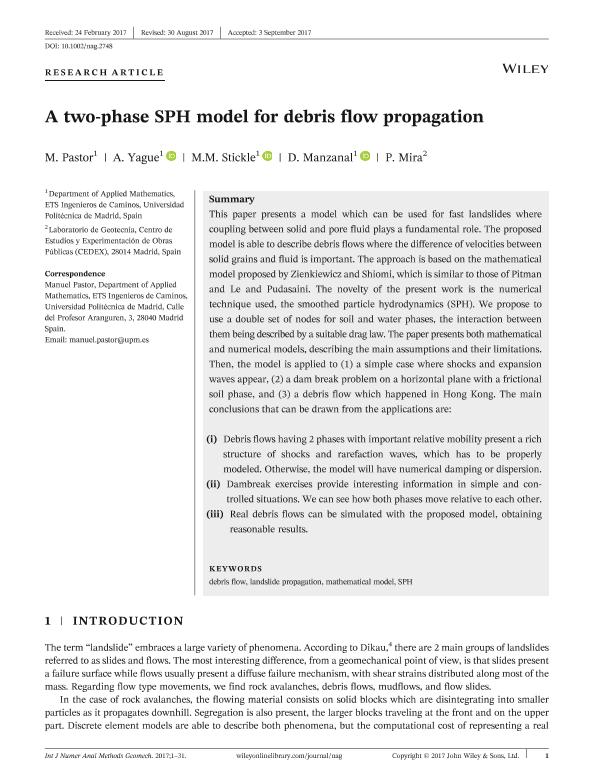Artículo
A two-phase SPH model for debris flow propagation
Fecha de publicación:
02/2018
Editorial:
John Wiley & Sons Ltd
Revista:
International Journal For Numerical And Analytical Methods In Geomechanics
ISSN:
0363-9061
Idioma:
Inglés
Tipo de recurso:
Artículo publicado
Clasificación temática:
Resumen
This paper presents a model which can be used for fast landslides where coupling between solid and pore fluid plays a fundamental role. The proposed model is able to describe debris flows where the difference of velocities between solid grains and fluid is important. The approach is based on the mathematical model proposed by Zienkiewicz and Shiomi, which is similar to those of Pitman and Le and Pudasaini. The novelty of the present work is the numerical technique used, the smoothed particle hydrodynamics (SPH). We propose to use a double set of nodes for soil and water phases, the interaction between them being described by a suitable drag law. The paper presents both mathematical and numerical models, describing the main assumptions and their limitations. Then, the model is applied to (1) a simple case where shocks and expansion waves appear, (2) a dam break problem on a horizontal plane with a frictional soil phase, and (3) a debris flow which happened in Hong Kong. The main conclusions that can be drawn from the applications are: Debris flows having 2 phases with important relative mobility present a rich structure of shocks and rarefaction waves, which has to be properly modeled. Otherwise, the model will have numerical damping or dispersion. Dambreak exercises provide interesting information in simple and controlled situations. We can see how both phases move relative to each other. Real debris flows can be simulated with the proposed model, obtaining reasonable results.
Palabras clave:
DEBRIS FLOW
,
LANDSLIDE PROPAGATION
,
MATHEMATICAL MODEL
,
SPH
Archivos asociados
Licencia
Identificadores
Colecciones
Articulos(INTECIN)
Articulos de INST.D/TEC.Y CS.DE LA ING."HILARIO FERNANDEZ LONG"
Articulos de INST.D/TEC.Y CS.DE LA ING."HILARIO FERNANDEZ LONG"
Citación
Pastor, M.; Yague, A.; Stickle, M.M.; Manzanal, Diego; Mira, P.; A two-phase SPH model for debris flow propagation; John Wiley & Sons Ltd; International Journal For Numerical And Analytical Methods In Geomechanics; 42; 3; 2-2018; 418-448
Compartir
Altmétricas




